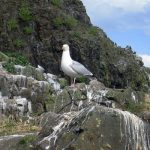Three new studies of how the world works show that seabird excrement plays an unexpected role, as do polar algae and rotting trees.
 The world’s seabirds don’t just live off the land, they also nourish it: their excrement delivers 591,000 tons of nitrogen and 99,000 tons of phosphorus to feed plant communities in the soil and the water.
The world’s seabirds don’t just live off the land, they also nourish it: their excrement delivers 591,000 tons of nitrogen and 99,000 tons of phosphorus to feed plant communities in the soil and the water.
